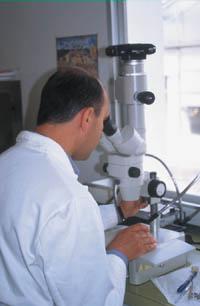Genetic transformation in agriculture and food
1999/10/01 Ruiz de Galarreta, Jose Ignacio Iturria: Elhuyar aldizkaria

Agriculture has been based from the beginning on the selection of certain species, and in them, especially varieties with favorable characteristics, both for planting and to achieve greater quantity and quality of the product. Genetic improvement is the implementation of a scientific methodology in the aforementioned process. Thanks to this, together with the implementation of new agricultural products and new modern agricultural techniques, seeds have been obtained that have achieved the current yield of agriculture. Genetic improvement is based on the natural variability of planted species and nearby heirs that can cross with them. If the introduction of a particular characteristic to a particular species were interesting and there was no such characteristic in the available varieties, genetic improvement could not act. Molecular biology is being worked on, more or less in the last 15 years.
The application of recombinant DNA technology has meant a revolution in the field of plant genetic improvement. Until then, genetic improvement has been done by selecting variateras and crossing techniques. In addition to a slow and expensive process, they were techniques with insurmountable genetic barriers.
Altered plants have the following objectives:
- Tolerance or resistance to organisms that consume, contaminate and destroy plants.
- Tolerance to extreme situations such as drought, salinity, heat/cold.
- Productivity.
- Achieve certain compositional, conservation or processing characteristics in plants (more nutritious composition, reduction of natural toxins or production of compounds of pharmacological interest).
So far a lot of corn, tomato, soy, potato, cotton, rice, sunflower, beet, tobacco, alfalfa and vegetables have been transformed. Almost 60 species of GM plants are researching before their commercialization (about 20,000 experiences worldwide).
Other applications of this technology allow the production of hormones in plants of therapeutic and enzymatic interest. For example, by having the cholera toxin subunit B gene, they have developed a transgenic potato that immunizes this disease. Likewise, genes have been developed that encode high value-added proteins in mammals of various mammals. They are drugs such as plasminogen activator or anti-hemophilia factor. In the case of fermented foods, lactic bacteria and transgenic yeasts have been obtained to obtain cheese with less ripening time or fruity wine.
To date 16 GM products have been extracted on the market in Europe: 12 transgenic plants, 3 vaccines and analysis kit to locate bacteria that may be present in milk. All of them have been analyzed in depth before the granting of marketing authorization.

The European Union has passed several laws to protect consumer health. The requirements are based on determining the nutritional composition of transgenic food and detecting possible allergies or toxicity. Other foods are not subjected to this type of testing, but their effect would be mandatory. The control of the possible risks to the environment and human health of the activities of genetically modified organisms in Spain is established in Law 15/94, of 3 June, and in the Regulations approved by Decree 951/1997. Two community directives (90/219). and 90/220 EEC) incorporated into Spanish legislation. In addition, the labelling of GM foods for human consumption, such as soy and corn, has been regulated through the Regulations of the Ministers of Agriculture of the Council of the European Union (1139/98, May 1998). It entered into force on 3 September 1998, replacing Regulation 1813/97.
However, one of the topics that is most debated in European regulations is labeling, since it is intended to appear in all transgenic foods that are sold. That is why the law is still waiting for changes.
Controls to which genetically modified varieties must be subjected, twice as large as conventional foods, must ensure the consumer and the farmer not only safety and health but also effectiveness in their use. The first requirement is registration in the Register of Commercial Varieties, both in Spain and in the organization operating in Europe. Registration requirements can be grouped into three types of criteria: identification, agricultural value and disease resistance.
Transgenic foods are, in short, an indisputable reality. The scientists who work on these issues cannot ignore the effects of their society, but must face the responsibility of informing society about their potential risks and their enormous opportunities.
José Ignacio Ruiz de Galarreta (NEIKER)

Gai honi buruzko eduki gehiago
Elhuyarrek garatutako teknologia




